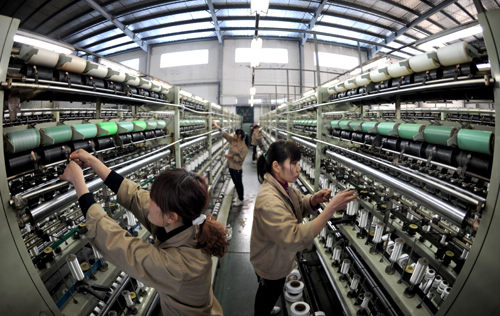|
 |
|
FULL SWING: Workers on the production line in Yiwu Langsha Knitting Co. Ltd. in southeast coastal Zhejiang Province (ZHANG JIANCHENG) |
The report on China Economy and Finance Outlook (Q2 2012) released by the International Finance Research Institute with the Bank of China (BOC) on March 28 bluntly pointed out the top four risks to China's economy, namely, excessive production capacity, volatile position for foreign exchange purchase, shrinking credit growth rate and the real estate bubble.
While other research institutes, such as the International Monetary Fund and the Institute of Economics under the Chinese Academy of Social Sciences, are expressing optimism about China's economic outlook, the BOC report reminded people to focus more on the risks and malaise in the Chinese economy than the abundance of positive information.
In fact, the influence and impact of the economic growth of China, the world's second largest economy, on the rest of the world have never been overstated, especially when other major economies have yet to recover from the financial crisis.
In the BOC report, overcapacity topped the major risks in the Chinese economy. Overcapacity has become increasingly problematic in China, with some major industrial products seeing prices plunge, sales-output ratio decrease, profits decline and losses increase, said the BOC report.
The fact is that excessive production capacity is to blame for the price plunge. In China's steel industry last year, domestic demand for crude steel was 660 million tons, while the total capacity reached 770 million tons. Serious overcapacity forced the price of iron ore and steel products to plummet. Last September, the China Iron Ore Price Index stood at around 600. Six months later it plunged to 480. During the same period, the Composite Steel Price Index decreased by more than 10 percent from 135 to 120.
According to Huang Zhiqiang, Director of the International Finance Research Institute of the BOC, at the micro level, overcapacity will cause low utilization of capacity, waste of economic resources and low efficiency in business operation. At the macro level, overcapacity prevalent in many industries will cause a dramatic decline in the general price level, mounting pressures of inflation, low investment assumption and fragile consumer sentiment. These will put pressures on economic growth, drive up non-performing assets in the banking sector and send up warning flares for financial risks.
"Although some of these negative effects have not taken place, we need to take preventive measures," said Huang.
The BOC report also included a position for foreign exchange purchase as one of the major risks in the Chinese economy.
"The dramatic fluctuation in China's position for foreign exchange purchase made it hard for its central bank to create an effective monetary policy," said the BOC report.
The so-called position for foreign exchange purchase, which is mainly the central bank's purchase of foreign currencies from commercial lenders in the interbank market, is often used as a measure of capital inflows to China.
According to data released by the People's Bank of China (PBOC), China's central bank, the country's forex purchasing position increased 25.1 billion yuan ($3.98 billion) in February, a dramatic decrease compared to 140.9 billion yuan ($22.37 billion) in January.
Most financial analysts estimated that China's position for foreign exchange purchase will total about 2 trillion yuan ($317.46 billion) this year, far lower than the average level of 3 trillion yuan ($476.19 billion) in the past several years.
"The decrease in position for foreign exchange purchase was the result of weakening yuan appreciation expectation. The stronger the yuan appreciation expectation, the higher the position for foreign exchange purchase," said Huang.
The biggest change that comes along with the position for foreign exchange purchase decrease is that the central bank will have bigger space to adjust its monetary policy, which is conducive to ensuring the healthy development of the Chinese economy.
But other worries have arisen. With the European debt crisis generally under control, with excessive liquidity constantly provided by developed economies and with the Chinese economy free from the fear of a hard landing, hot money inflow will continue to bother Chinese monetary policy makers.
| 